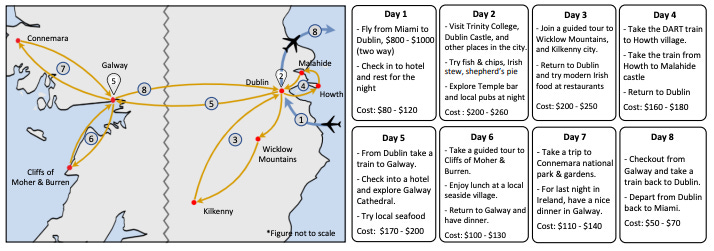We visited Australia Zoo on holiday in December, and my son has gone all-in on the Irwins ever since. So, naturally, I asked ChatGPT to create a text-based role-playing game to indulge his croc obsession.
Pretend you are a computer game that uses text to describe a scene.
The player can then interact with the scene using natural language.
The initial starting point for the game is the entrance to
Australia Zoo.What followed was a realistic interaction about a real place. It knew the shows, attractions, and, most surprisingly, the geography. Crikey! I haven’t seen much coverage of generative AI in geospatial applications, but the models are wrestling with some emergent location-based understanding.
Fortunately, some good folks from academia had the same thought, and on May 30, they published the GPT4GEO paper. The collaboration between researchers at universities in the UK, Germany and China explores the factual geographic knowledge of GPT-4 and its application-centric geographic reasoning. They conclude, “We find GPT-4 to have a remarkable understanding of the world.”
The factual or descriptive knowledge of GPT-4 is fascinating, but I don’t think it matters too much. Retrieval augmented generation (RAG) could provide accurate geospatial data from Google Maps and other sources. I was surprised that there isn’t yet a plugin on ChatGPT to do this; it won’t be long before there is.
The application-centric geographic reasoning, such as route planning, navigation, itinerary planning, and supply chain analysis, gets interesting. The paper showed that the model can develop “creative, plausible travel routes” and “shows strong capabilities of direction-based navigation.”
Fire Safety GPT
I’ve been advising Locatrix, an indoor mapping software company. Locatrix focuses on fire safety, and I was curious whether GPT-4 could generate an evacuation plan based on an office floor plan or recommend where to place fire extinguishers. The short answer is yes, yes, it can.
I asked GPT-4 to “Create the floor plan and detailed layout of a 5,000 square foot floor of an office building. Return it as JSON.” It did a solid job describing the area, including a reception, four meeting rooms, six private offices and an open office space.
I then followed up with “Create an evacuation plan for this office”, which it proceeded to do. At a high level, it looks pretty good and claims, “Each exit point has a route from every section of the office floor (Reception, OpenOfficeSpace, PrivateOffices, MeetingRooms). The path represents the sequence of positions to be traversed from each section to reach the exit point.”
To push the limit, I asked, “Suggest locations for fire extinguisher locations to meet the fire code in San Francisco.” Sure enough, it returned suggested plausible locations and details on how it complied with the local code. “As per the specific codes applicable to San Francisco, each extinguisher should be: within 75 feet of all portions of the premise, within 30 feet of any cooking equipment, and regularly inspected and maintained.“
You can read the full transcript of my interaction with ChatGPT and try it out for yourself. It could be better. For example, I couldn’t get it to produce any decent visualizations. Nevertheless, you can see the future from here.
Coding and data analysis are tasks already well suited to the GPT architecture. Geospatial features can all be represented as text too, and I suspect that a few years from now, every large building or campus will have a copilot to help with space planning, safety, and maintenance.
“Robot, we need to evacuate. Help everyone get out now!” is not far off. Every building will be an AI building.
[1] GPT4GEO: How a Language Model Sees the World's Geography by Jonathan Roberts, Timo Lüddecke, Sowmen Das, Kai Han, Samuel Albanie. Submitted to Arxiv on May 30, 2023.



